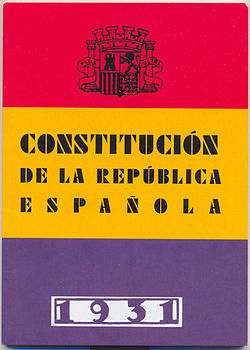| Spanish Constitution | |
|---|---|
 Preface to the Spanish Constitution of 1931 | |
| Ratified | 9 December 1931 |
| Repealed | 1 April 1939 (end of the Spanish Civil War) |
| Signatories | Niceto Alcalá-Zamora |
| Full text | |
The Spanish Constitution of 1931 was approved by the Constituent Assembly on 9 December 1931. It was the constitution of the Second Spanish Republic (founded 14 April 1931) and was in force until 1 April 1939. This was the second period of Spanish history in which both head of state and head of government were democratically elected.
A constitutional draft prepared by a commission under a reformist Catholic lawyer Ángel Ossorio y Gallardo having been rejected, an amended draft was approved by the Constituent Assembly on 9 December 1931. It created a secular democratic system based on equal rights for all citizens, with provision for regional autonomy. It introduced female suffrage, civil marriage and divorce. It permitted the state to expropriate private property, with compensation, for reasons of broader social utility. It also established free, obligatory, secular education for all and dissolved the Jesuits.
The Republic "was the culmination of a process of mass mobilisation and opposition to the old politics of notables."[1] According to the historian Mary Vincent the Constitution envisaged "a reforming regime with an explicit and self-conscious view of what modernising Spain should entail. A secular state operating according to the rule of law with an admittedly ill-defined sense of social justice would open the way for an educated body of citizens to enjoy 'European' prosperity and freedom."[2] According to Frances Lannon however, the articles on property and religion, with their exaltation of state power and disregard for civil rights, "virtually destroyed any prospect there had been for the development of a Catholic, conservative, Republicanism."[3]
The new Constitution, among other laws, is described as having been anticlerical. While it afforded broad civil liberties and democratic representation, it abolished privileges associated with the Catholic Church, and did not explicitly protect Roman Catholic interests or rights. As anticlerical sentiment had been growing for decades, it culminated in escalating mob violence against the Church which the new government was unable to curb. This resulted in severely strained church-state relations, noted as a significant cause of the breakdown of the Republic and of the Spanish Civil War.[4][5]
- ^ Francisco J.Romero Salvado, Politics and Society in Spain 1898-1998 p.69
- ^ Mary Vincent, University of Sheffield, review of Romero's Politics and Society in Spain 1898-1998 , 'Reviews in History' April 2000
- ^ Frances Lannon, p.20 the Spanish Civil War, 1936-1939 ISBN 978-1-84176-369-9
- ^ "Anticlericalism | religion". Encyclopedia Britannica. Retrieved 2020-11-24.
- ^ Cite error: The named reference
libro.uca.eduwas invoked but never defined (see the help page).